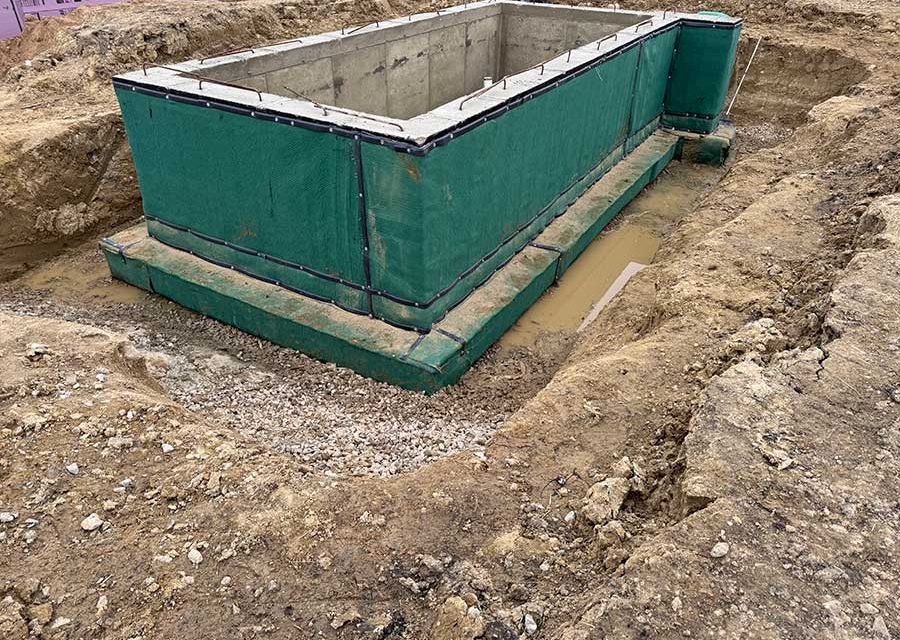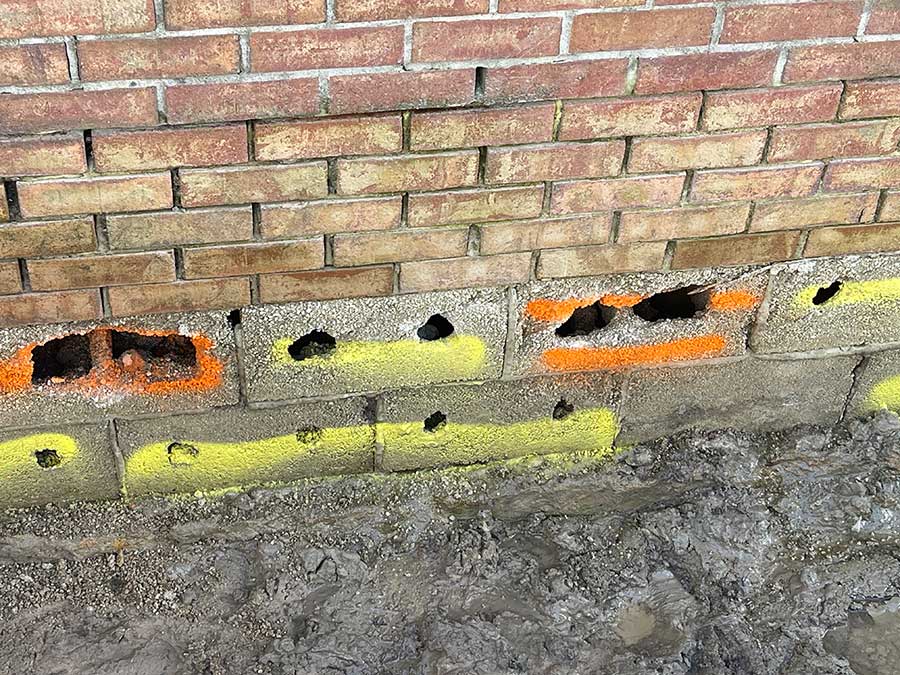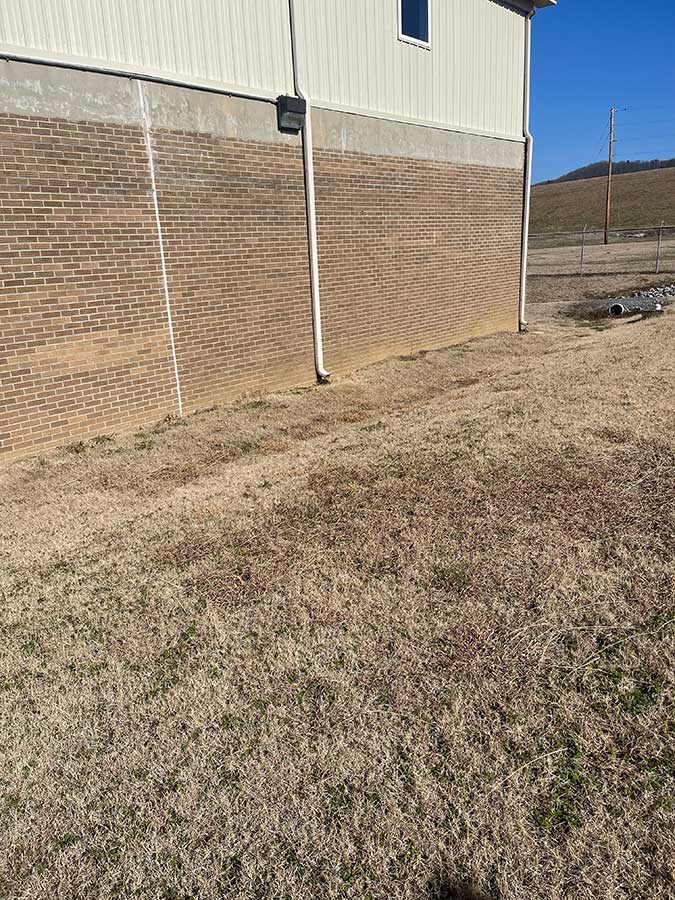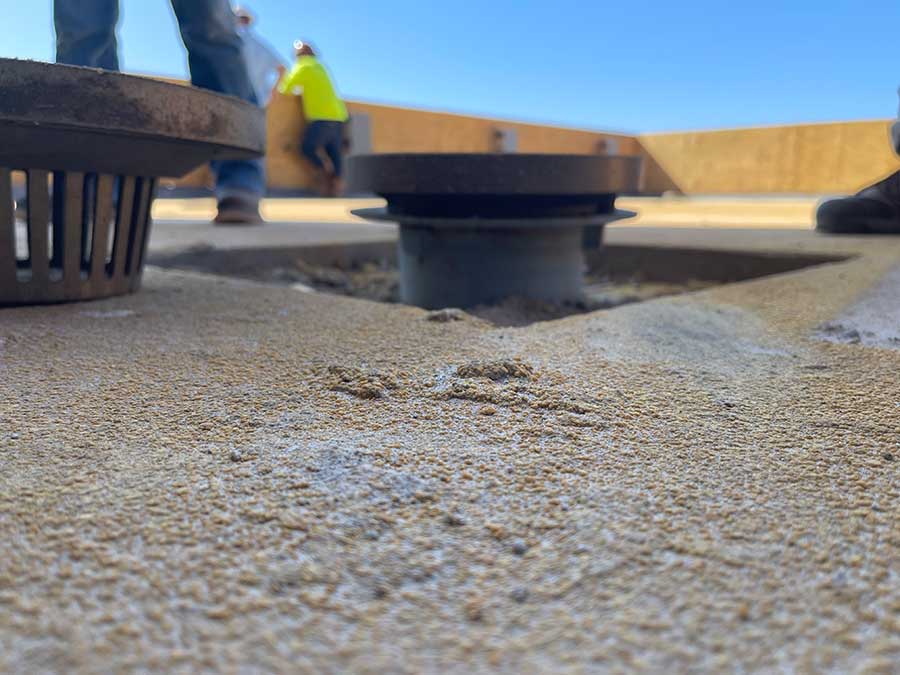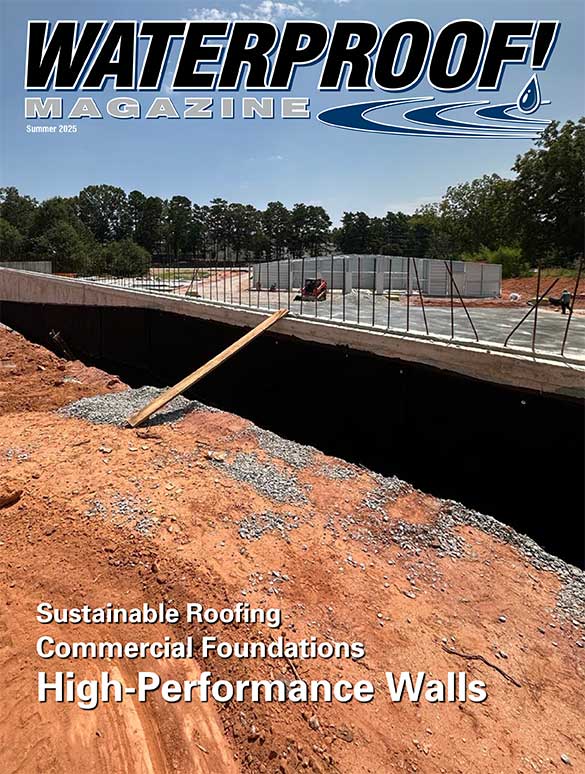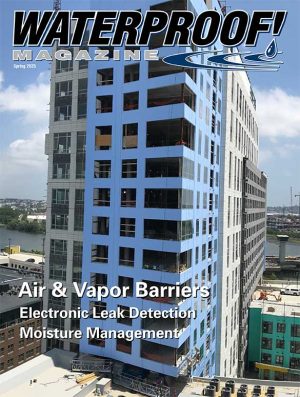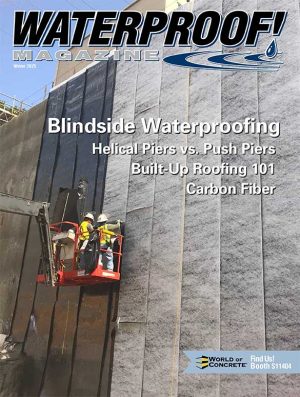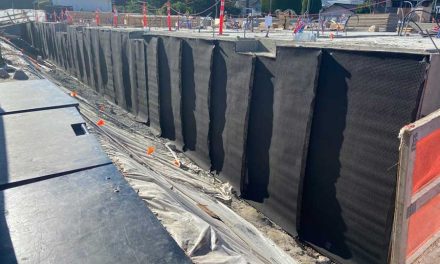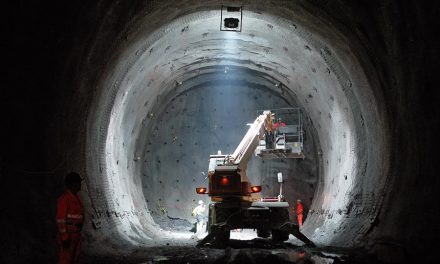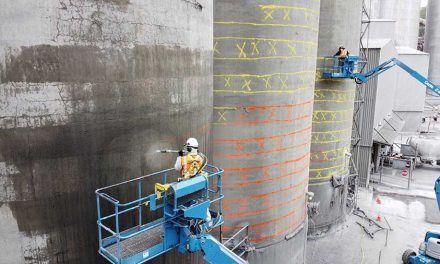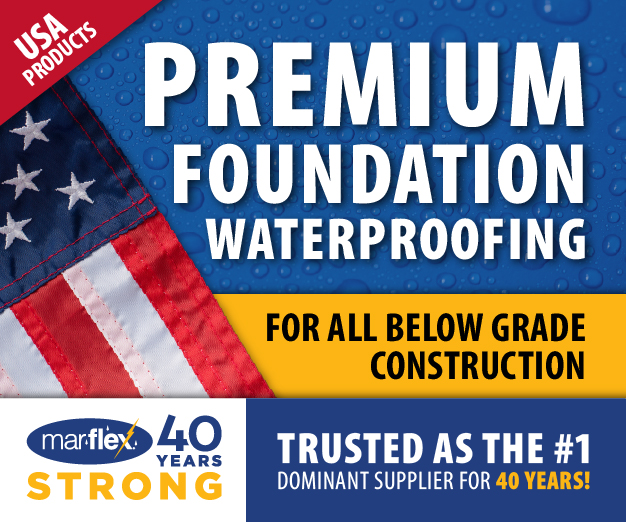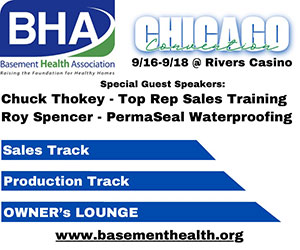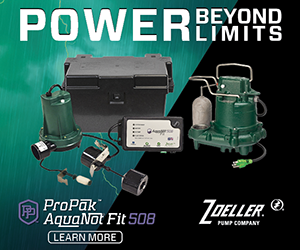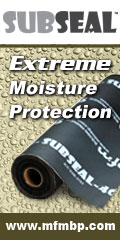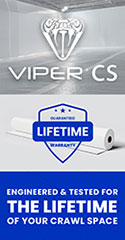By Wes Settlemyre, Commercial Channel Director, GMX Inc.
Photos courtesy of GMX Inc.
The foundation is arguably the most critical component of a commercial building. It bears the structure’s weight, provides stability, and serves as a barrier between the building and the surrounding soil. However, one of the greatest threats to a foundation is water infiltration.
When water seeps into a foundation, it can cause significant structural deterioration, leading to cracking, spalling, and, in extreme cases, catastrophic failure. It can also create persistent moisture issues that foster mold growth, damage electrical and mechanical systems, and increase maintenance costs.
Modern commercial buildings are also being constructed in increasingly challenging environments — urban spaces with limited excavation areas, high groundwater zones, and regions experiencing more intense rainfall due to climate change. These factors make effective waterproofing not just an option but a necessity.
This comprehensive guide explores critical aspects of commercial foundation protection, from basic waterproofing techniques to advanced strategies like under-slab and blindside applications. We’ll examine how these systems integrate with horizontal decks and weather-resistant barriers, address above-grade water intrusion, highlight common pitfalls, and introduce emerging technologies and sustainability practices in modern waterproofing.
Water’s Impact on Foundations
Water can enter a commercial foundation in several ways. Hydrostatic pressure in the soil exerts force against foundation walls, pushing moisture through cracks and pores. Through capillary action, water rises through porous concrete, leading to damp conditions inside the building. Improper drainage can cause lateral water migration into foundation walls. Over time, small structural cracks allow water intrusion, worsening the problem. Additionally, rainwater, melting snow, and poor drainage from roofs and walls can introduce water into the foundation from higher elevations.
Once water infiltrates a foundation, the consequences can be severe. Concrete degradation occurs as water erodes calcium hydroxide in concrete, weakening its structure. Water reaching rebar causes corrosion of steel reinforcement, with rust expansion that cracks concrete. Freeze-thaw damage happens when water trapped in concrete expands when frozen, leading to cracking.
Persistent moisture leads to mold growth and air quality issues inside buildings. Ultimately, continuous water infiltration compromises structural integrity by undermining foundation stability. With these risks in mind, effective waterproofing solutions are crucial in any commercial project.
Key Waterproofing Systems for Commercial Foundations
Positive-side waterproofing involves applying waterproofing membranes or coatings to the exterior face of the foundation wall before backfilling. This prevents water from reaching structural components.
Several materials are commonly used for positive-side waterproofing. Liquid-applied membranes create elastomeric coatings that form a seamless barrier. Sheet membranes provide durable, prefabricated protection with materials such as PVC or rubberized asphalt. Bentonite panels offer clay-based protection that swells when exposed to moisture, sealing off water entry points.
The advantages of positive-side waterproofing are significant. It directly protects the concrete from water exposure, works effectively with drainage systems, and can be combined with insulation for thermal efficiency. However, limitations exist, as it requires excavation, which may not be feasible in tight urban areas, and installation errors can lead to leaks.
Blindside Waterproofing
Blindside waterproofing is applied before pouring concrete, making it ideal for urban environments where excavation space is limited. It is installed against a soil-retaining system such as sheet piling, secant walls, or shotcrete.
Materials typically used include pre-applied sheet membranes designed to bond with concrete as it cures and spray-applied elastomeric coatings that provide flexible solutions for blindside applications.
Blindside waterproofing offers several advantages. It allows waterproofing in dense, restricted areas, forms a strong, continuous bond with concrete, and can withstand lateral groundwater pressure. However, this approach requires careful quality control to avoid punctures before concrete is poured, and repairing blindside systems post-construction is particularly difficult.
Above-Grade Water Intrusion
Water doesn’t only infiltrate from below; it can also enter from above grade, causing severe foundation problems. Several factors contribute to above-grade water intrusion. Inadequate roof drainage with poorly directed roof runoff can accumulate around the foundation. Improper flashing and degraded sealants create gaps that allow water entry. Exterior cladding systems that fail to shed water effectively can funnel moisture down to the foundation. Poor surface grading with landscaping that slopes toward the building directs water into foundation walls.
To address these issues, several solutions can be implemented. Extending waterproofing membranes above grade prevents capillary action. Installing proper drainage systems including gutters, downspouts, and perimeter drains directs water away from the structure. Ensuring proper wall flashing and caulking prevents water penetration at transition points. Maintaining proper grading directs surface water away from the foundation. Remember the golden rule: Direct the water away from, not into the building!
Best Practices for Long-Lasting Waterproofing
Successful waterproofing begins with soil and drainage evaluation. Always assess site conditions before selecting a waterproofing system to ensure the solution matches the specific challenges of the location. Proper membrane installation is critical — avoid gaps, wrinkles, or punctures in membranes that could create entry points for water.
Seam and overlap sealing demands special attention. Use adhesives, tapes, or welding to ensure watertight joints where membrane sections meet. Drainage system integration is essential — always pair waterproofing with perimeter drains and weep holes to channel water away from the foundation.
Above-grade moisture management cannot be overlooked. Ensure proper flashing, grading, and facade waterproofing to prevent water from traveling down to the foundation level. Finally, commit to regular maintenance and inspections. Conduct water tests post-installation and schedule annual inspections to catch and address small issues before they become major problems.
Conclusion
Waterproofing commercial foundations is an investment in the longevity and performance of a structure. While initial costs may be higher than basic moisture protection, proper waterproofing saves millions on future repairs. The most successful projects integrate multiple waterproofing techniques, ensuring protection from every possible angle.
Would you rather pay for waterproofing upfront or deal with costly water damage later? The choice is clear.
References
ACI 515.2R-13 – Guide to Waterproofing Concrete
ASTM D5385 – Hydrostatic Pressure Resistance of Waterproofing Membranes
NRCA Waterproofing Manual – Best Practices for Commercial Buildings

Wes Settlemyre
Commercial Channel Director at GMX Inc
Wes Settlemyre is the Commercial Channel Director at GMX Inc. a subsidiary of Garland Industries. He is a results-driven professional with a strong track record of innovation and technical expertise. With deep experience in building envelope systems, he specializes in developing cutting-edge solutions that drive efficiency, performance, and reduce risk. Passionate about problem-solving and continuous improvement, Wes leverages advanced technical knowledge to optimize processes and deliver impactful results. Known for a forward-thinking approach, he excels at bridging technology and strategy to create lasting business value. Get in touch at wsettlemyre@gmxco.com.
Summer 2025 Back Issue
Price range: $4.95 through $5.95
High-Performance Liquid Waterproofing for Walls
Sustainable Roofing
Waterproofing Commercial Foundations
Description
Description
High-Performance Liquid Waterproofing for Walls
By Vanessa Salvia
In an industry where waterproofing technology continues to evolve, liquid waterproofing systems have emerged as innovative solutions for wall applications.
Sustainable Roofing
By Richard C. Hayden, GRP ASLA-Emeritus
The roof is one of the most important components in any building. The roof provides the primary defense against the elements of sun, snow, and rain.
Waterproofing Commercial Foundations
By Wes Settlemyre
The foundation is arguably the most critical component of a commercial building. However, one of the greatest threats to a foundation is water infiltration.
Additional Info
Additional information
| Weight | N/A |
|---|---|
| Magazine Format | Digital Download Magazine, Print Mailed Magazine |

